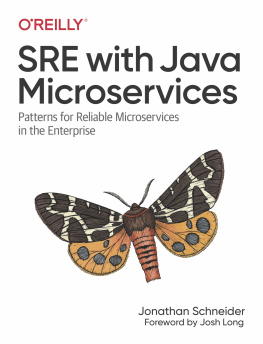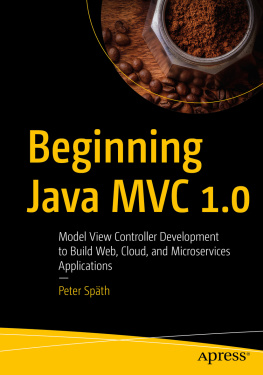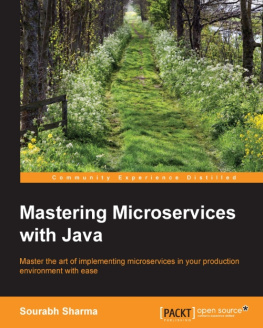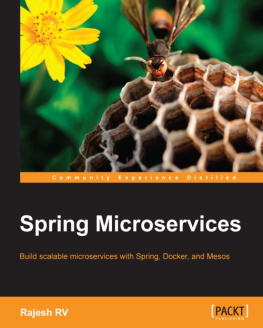Jonathan Schneider - SRE with Java Microservices
Here you can read online Jonathan Schneider - SRE with Java Microservices full text of the book (entire story) in english for free. Download pdf and epub, get meaning, cover and reviews about this ebook. year: 2020, publisher: OReilly Media, Inc., genre: Computer. Description of the work, (preface) as well as reviews are available. Best literature library LitArk.com created for fans of good reading and offers a wide selection of genres:
Romance novel
Science fiction
Adventure
Detective
Science
History
Home and family
Prose
Art
Politics
Computer
Non-fiction
Religion
Business
Children
Humor
Choose a favorite category and find really read worthwhile books. Enjoy immersion in the world of imagination, feel the emotions of the characters or learn something new for yourself, make an fascinating discovery.
- Book:SRE with Java Microservices
- Author:
- Publisher:OReilly Media, Inc.
- Genre:
- Year:2020
- Rating:3 / 5
- Favourites:Add to favourites
- Your mark:
- 60
- 1
- 2
- 3
- 4
- 5
SRE with Java Microservices: summary, description and annotation
We offer to read an annotation, description, summary or preface (depends on what the author of the book "SRE with Java Microservices" wrote himself). If you haven't found the necessary information about the book — write in the comments, we will try to find it.
SRE with Java Microservices — read online for free the complete book (whole text) full work
Below is the text of the book, divided by pages. System saving the place of the last page read, allows you to conveniently read the book "SRE with Java Microservices" online for free, without having to search again every time where you left off. Put a bookmark, and you can go to the page where you finished reading at any time.
Font size:
Interval:
Bookmark:

by Jonathan Schneider
Copyright 2020 Jonathan Schneider. All rights reserved.
Printed in the United States of America.
Published by OReilly Media, Inc. , 1005 Gravenstein Highway North, Sebastopol, CA 95472.
OReilly books may be purchased for educational, business, or sales promotional use. Online editions are also available for most titles (http://oreilly.com). For more information, contact our corporate/institutional sales department: 800-998-9938 or corporate@oreilly.com .
- Acquisitions Editor: Melissa Duffield
- Development Editor: Melissa Potter
- Production Editor: Deborah Baker
- Copyeditor: JM Olejarz
- Proofreader: Amanda Kersey
- Indexer: WordCo Indexing Services, Inc.
- Interior Designer: David Futato
- Cover Designer: Karen Montgomery
- Illustrator: OReilly Media, Inc.
- October 2020: First Edition
- 2020-08-26: First Release
See http://oreilly.com/catalog/errata.csp?isbn=9781492073925 for release details.
The OReilly logo is a registered trademark of OReilly Media, Inc. SRE with Java Microservices, the cover image, and related trade dress are trademarks of OReilly Media, Inc.
The views expressed in this work are those of the author, and do not represent the publishers views. While the publisher and the author have used good faith efforts to ensure that the information and instructions contained in this work are accurate, the publisher and the author disclaim all responsibility for errors or omissions, including without limitation responsibility for damages resulting from the use of or reliance on this work. Use of the information and instructions contained in this work is at your own risk. If any code samples or other technology this work contains or describes is subject to open source licenses or the intellectual property rights of others, it is your responsibility to ensure that your use thereof complies with such licenses and/or rights.
978-1-492-07392-5
[GP]
To production and beyond!
Buzz Lightyear (paraphrasing)
I know Buzz said to infinity and beyond, but that whole notion never sat well with me as a child. How could you go beyond infinity? It was only later in life, when I became a software engineer, that it dawned on mesoftware is never complete. Its never finished. Its...infinite. Buzz missed his calling in software!
Software has no end. Software is like the oceans, the stars, and the bugs in your code: endless! Hopefully, thats not controversial. The last few decades have seen all of us in the software field pivot around this insight: the endless tail of software maintenance is the most expensive part of what we do. A good deal of the significant movements in software figure around that. Testing and continuous integration. Continuous delivery. Cloud computing. Microservices. Its not hard to get to production the first time, but these practices optimize for the many subsequent trips to production. They optimize for day two. They optimize for cycle time: how quickly can you take an idea and see it delivered into production, from concept to customer? They optimize for and beyond.
This insightthat software has no endintroduces a ton of new practices and puts the lie to as many existing practices. It changes the focus from the initial development and MVP to the maintenance and management of that software. The focus is on production.
I love production. You should love production. You should go to production, as early and often as possible. Bring the kids. Bring the family. The weathers amazing.
Great software engineers build for production and for the return trip. They build for the endless journey. It is no longer acceptable to wring our collective hands and throw our code over the proverbial wall: Well, it works on my machine! Now you deploy it! Theres a whole new frontier out thereproductionthat demands a different set of skills. Site reliability engineering (SRE) is, according to Ben Treynor, founder of Googles site reliability team, what happens when a software engineer is tasked with what used to be called operations. SREs share a lot of skills with traditional software engineers, but they target them differently, with an eye on production.
Spring Boot developers can and should develop SRE skills, and few know the ropes better than this books author, Jonathan Schneider. Spring Boot succeeds by being laser-focused on production. It is extraordinary because it, along with frameworks like Dropwizard, is built stem to stern for production. It supports easy aggregation of metrics with Micrometer, so-called fat .jar deployments, the Actuator management endpoints, application life cycle events, 12 Factor-style configuration, and more. Spring Cloud is a set of Spring Boot extensions designed to support the microservices architecture. And all that is to say nothing of the rich platform support. Spring Boot is container-native. It and platforms like Cloud Foundry or Kubernetes are two sides of the same coin. Spring Boot supports graceful shutdown, health groups, liveness and readiness probes, Docker image generation (leveraging CNCF buildpacks), and so much more.
And Ill bet you didnt know about most of those features! But Jonathan knows. Jonathan lives and breathes this stuff. He created the Micrometer project, a dimensional metrics framework that supports dozens of different metrics and monitoring platforms, and then helped integrate it into Spring Boots Actuator module, and into countless other third-party open source projects. Ive watched him work on metrics, continuous delivery tools like Spinnaker, and observability tools like Micrometer, and generally pave the path to production for others. Hes got years of experience in leveraging Spring and Spring Boot at a global scale, and while he can sling Spring Data repositories and craft HTTP APIs with the best of them, his genius is in the way he builds for that endless journey.
And now we can learn from him in this book.
is a manifesto of sortsread this to get in the right frame of mind for the book. I shouldve read this chapter first!
I shouldve, but I didnt. I skipped ahead to are a few hours very well spent. Theyre brilliant. 5/5: would (and did) read again.
introduces the clouds, core concepts, types of platforms, and patterns unique to these platforms. This chapter was one of the most insightful for me. It starts slowly, and the next thing you know, youre up to your deployment scripts in a game-changing discussion of continuous delivery, canary analysis, and more. Read this chapter twice.
gives you a framework and specific solutions to understand your codebase and its dependencies. Ive never seen all these concerns presented in a comprehensive framework like this.
is a fitting closing chapter to an amazing book in that it looks at the interactions of deployed services in production. By this point youll have learned how to get the software to production and how to observe services and their source code. This chapter is all about the service interactions and the dynamics of load on an architecture.
I learned something new in every chapter. The book is full of the wisdom of a true cloud native, and one that I think the community needs. Jonathan is a fantastic guide on the endless journey to production...and beyond.
Josh Long (@starbuxman)
Spring Developer Advocate
Spring team, VMware
San Francisco, CA
July 2020
Font size:
Interval:
Bookmark:
Similar books «SRE with Java Microservices»
Look at similar books to SRE with Java Microservices. We have selected literature similar in name and meaning in the hope of providing readers with more options to find new, interesting, not yet read works.
Discussion, reviews of the book SRE with Java Microservices and just readers' own opinions. Leave your comments, write what you think about the work, its meaning or the main characters. Specify what exactly you liked and what you didn't like, and why you think so.








![Ken Finnigan [Ken Finnigan] - Enterprise Java Microservices](/uploads/posts/book/119364/thumbs/ken-finnigan-ken-finnigan-enterprise-java.jpg)

